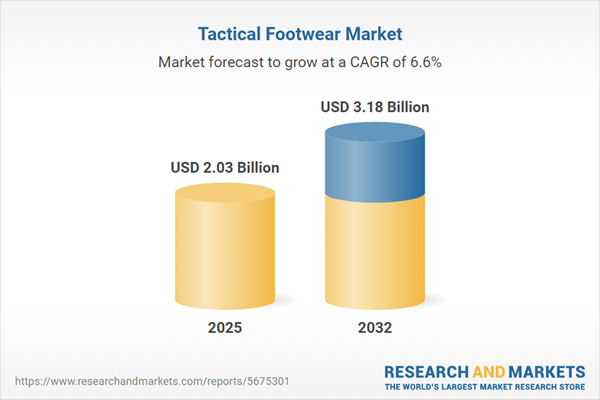Speak directly to the analyst to clarify any post sales queries you may have.
The tactical footwear market is undergoing significant transformation as B2B organizations strengthen procurement processes and focus on resilient supply chain strategies. Senior decision-makers seek adaptable, compliant sourcing solutions to address evolving operational requirements.
Market Snapshot: Tactical Footwear Market Overview and Growth
The global tactical footwear market exhibits consistent expansion, supported by persistent demand from military, law enforcement, and sectors dedicated to outdoor activities. Current projections anticipate sustained growth in both market size and adoption rates through 2032, as investments in specialized footwear for mission-critical and high-performance applications accelerate. Modern manufacturing technologies and the adoption of omnichannel distribution models empower suppliers to reinforce distribution networks while maintaining rigorous supply chain standards. As procurement models become more agile, decision-makers are increasingly alert to regulatory changes that influence both sourcing and organizational agility.
Tactical Footwear Market Scope & Segmentation
- Product Types: Includes boots, shoes, sandals, and sneakers that provide consistent performance during high-stress and variable operational scenarios across broad deployment needs.
- Material Composition: Features full-grain, split, and top-grain leather; advanced synthetic materials; and high-performance rubber—selected for compliance and resistance to wear within demanding environments.
- Pricing Segments: Offers economy, mid-tier, and premium categories, allowing tailored procurement according to diverse organizational budgets and value priorities.
- Applications: Caters to uses such as combat, hiking, training, and multipurpose functionality,, addressing safety and durability for sector-specific operational needs.
- Gender Fit: Provides men’s, women’s, and unisex options, supporting deployment flexibility and inclusive workforce requirements across industries.
- Distribution Channels: Utilizes digital procurement platforms, third-party marketplaces, specialist retailers, and traditional outlets to optimize product access and sourcing efficiency.
- End Users: Serves military, law enforcement, and outdoor-oriented organizations, each with unique sourcing criteria and supply chain expectations.
- Geographic Coverage: Covers the Americas, EMEA, and Asia-Pacific, with each region characterized by distinct compliance standards and supplier ecosystems, affecting procurement and vendor evaluation strategy.
- Company Profiles: Key industry players such as Nike, Adidas, Anta Sports, Under Armour, Wolverine Worldwide, Rocky Brands, Compass Diversified Holdings, ASICS Corporation, and Deckers Outdoor Corporation support benchmarking and informed selection.
Tactical Footwear Market: Key Takeaways for Senior Decision-Makers
- Innovative technical textiles and composite materials enhance product adaptability, allowing tactical footwear to deliver stable performance in varying and unpredictable environments.
- Use of digital procurement platforms streamlines buying cycles, enabling quicker responses to changing operational demands and procurement priorities.
- Supply chain transparency and strong traceability measures promote regulatory compliance and help minimize potential inventory disruptions during extended operations.
- Modular design approaches in footwear increase product flexibility, supporting seamless adaptation as organizational or regulatory conditions evolve.
- A wide range of suppliers and strategic inventory management by region improve readiness and help reduce supply-related risks in global markets.
- Balancing ongoing product innovation with compliance ensures organizations meet sourcing objectives while adhering to evolving standards and expectations.
Tariff Impact on Sourcing and Product Strategy
Shifts in global tariff policy are directly affecting tactical footwear sourcing strategies, encouraging many organizations to explore nearshoring and alternative production sites. The adoption of vertical integration and custom product development pathways supports sustained compliance and quick adaptation to new regulations. Transparent engagement with suppliers, consistent oversight, and development of regional inventory reserves have become fundamental for resilient supply chains. As disruptions become more prevalent, scenario-based contingency planning is being adopted to safeguard consistent product availability across key regions.
Methodology & Data Sources
This report draws on interviews with procurement and operations leaders, a thorough analysis of sector literature, and a comprehensive review of current regulatory frameworks. Insights are synthesized by subject matter experts to provide actionable guidance for those overseeing tactical footwear procurement and compliance.
Why This Report Matters for B2B Buyers
- Enables informed sourcing decisions by aligning tactical footwear procurement with operational and compliance requirements across regions and sectors.
- Supports organizations in building responsive resource planning and procurement strategies that navigate evolving market and regulatory contexts.
- Facilitates the adoption of innovative sourcing models to manage complex supply chain, compliance, and operational challenges inherent to tactical footwear procurement.
Conclusion: Driving Resilience and Capability
Strategic sourcing, advanced engineering, and reliable supplier networks are essential for organizations aiming to build resilience and agility in tactical footwear initiatives under shifting operational demands.
Additional Product Information:
- Purchase of this report includes 1 year online access with quarterly updates.
- This report can be updated on request. Please contact our Customer Experience team using the Ask a Question widget on our website.
Table of Contents
3. Executive Summary
4. Market Overview
7. Cumulative Impact of Artificial Intelligence 2025
Companies Mentioned
The companies profiled in this Tactical Footwear market report include:- Nike, Inc.
- Adidas AG
- Anta Sports Products Limited
- Under Armour, Inc.
- Wolverine Worldwide, Inc.
- Rocky Brands, Inc.
- Compass Diversified Holdings
- ASICS Corporation
- Wolverine World Wide, Inc.
- Deckers Outdoor Corporation
Table Information
| Report Attribute | Details |
|---|---|
| No. of Pages | 182 |
| Published | October 2025 |
| Forecast Period | 2025 - 2032 |
| Estimated Market Value ( USD | $ 2.03 Billion |
| Forecasted Market Value ( USD | $ 3.18 Billion |
| Compound Annual Growth Rate | 6.6% |
| Regions Covered | Global |
| No. of Companies Mentioned | 11 |









